
The Araceae are a family of monocotyledonous flowering plants in which flowers are borne on a type of inflorescence called a spadix. The spadix is usually accompanied by, and sometimes partially enclosed in, a spathe. Also known as the arum family, members are often colloquially known as aroids. This family of 114 genera and about 3,750 known species is most diverse in the New World tropics, although also distributed in the Old World tropics and northern temperate regions.

Amorphophallus is a large genus of some 200 tropical and subtropical tuberous herbaceous plants from the Arum family (Araceae), native to Asia, Africa, Australia and various oceanic islands. A few species are edible as "famine foods" after careful preparation to remove irritating chemicals. The genus includes the Titan arum of Indonesia, which has the largest inflorescence of any plant in the genus, and is also known as the 'corpse flower' for the pungent odour it produces during its flowering period, which can take up to seven years of growth before it occurs.

In botany, a spadix is a type of inflorescence having small flowers borne on a fleshy stem. Spadices are typical of the family Araceae, the arums or aroids. The spadix is typically surrounded by a leaf-like curved bract known as a spathe. For example, the "flower" of the well known Anthurium spp. is a typical spadix with a large colorful spathe.

Arum maculatum, commonly known as cuckoopint, jack-in-the-pulpit and other names, is a woodland flowering plant species in the family Araceae. It is native across most of Europe, as well as Eastern Turkey and the Caucasus.

Zantedeschia is a genus of eight species of herbaceous, perennial, flowering plants in the aroid family, Araceae, native to southern Africa(from South Africa northeast to Malawi). The genus has been introduced, in some form, on every continent.
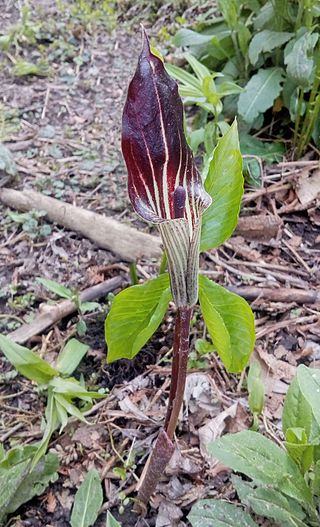
Arisaema triphyllum, the Jack-in-the-pulpit, is a species of flowering plant in the arum family Araceae. It is a member of the Arisaema triphyllum complex, a group of four or five closely related taxa in eastern North America. The specific name triphyllum means "three-leaved", a characteristic feature of the species, which is also referred to as Indian turnip, bog onion, and brown dragon.

Dieffenbachia seguine, widely known as dumbcane, as well as leopard lily or tuftroot, is a species of Dieffenbachia, a flowering aroid plant of the family Araceae. It is native to the neotropical realm of the Americas, from extreme southern Mexico and Belize and much of Central America, as well as the northern half of South America. It is found on many Caribbean islands and territories, including Cuba, Grand Bahama, Grenada, Guadeloupe, Hispaniola, Îles des Saintes, Jamaica, Martinique, Puerto Rico, Saba, Saint Kitts and Trinidad and Tobago. D. seguine is also found on the Galápagos islands of Santa Cruz and San Cristóbal, where it was likely introduced by humans.

Alocasia odora, also known as night-scented lily, Asian taro or giant upright elephant ear, is a species of flowering plant native to East and Southeast Asia. Traditionally, A. odora is sometime used as a medicine for the treatment of the common cold in Vietnam.
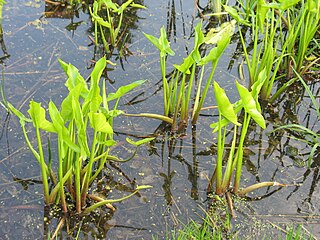
Peltandra virginica is a plant of the arum family known as green arrow arum and tuckahoe. It is widely distributed in wetlands in the eastern United States, as well as in Quebec, Ontario, and Cuba. It is common in central Florida including the Everglades and along the Gulf Coast. Its rhizomes are tolerant to low oxygen levels found in wetland soils. It can be found elsewhere in North America as an introduced species and often an invasive plant.

The titan arum is a flowering plant in the family Araceae. It has a large unbranched inflorescence; a tall single leaf, branched like a tree; and a heavy tuber which enables the plant to produce the inflorescence. A. titanum is endemic to rainforests on the Indonesian island of Sumatra.

Anubias gigantea is an aquatic to riparian aroid species belonging to the genus Anubias, within the Araceae. It was first mentioned by Auguste Chevalier in 1920, based on material that he had collected in Guinea, West Africa. The formal description followed in 1939 by John Hutchinson. It is closely related to A. afzelii, basically only differing from that species by the form of the leaf-blade, with mature growth appearing somewhat different than the juvenile plants.
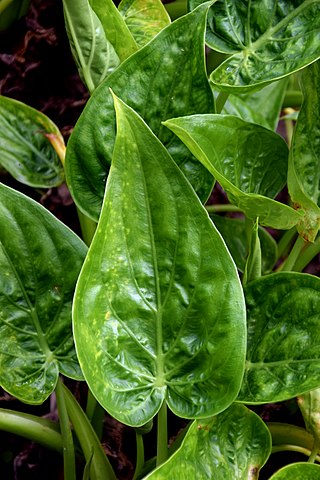
Alocasia cucullata is a species of flowering plant in the arum family known by the common names Chinese taro, Chinese ape, Buddha's hand, and hooded dwarf elephant ear. It is kept as an ornamental plant.
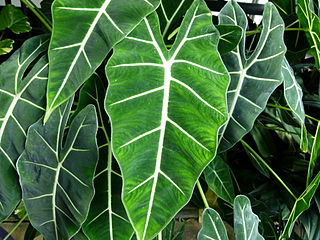
Alocasia micholitziana, commonly known as the green velvet taro or green velvet alocasia, is a plant in the family Araceae. It is endemic to the island of Luzon in the Philippines. It is commonly grown as an ornamental plant worldwide.

Monstera membranacea is a species of flowering plant in the genus Monstera of the arum family, Araceae.
Alocasia melo is a species of flowering plant in the family Araceae, native to Sabah state in Malaysia. It grows on ultramafic soils. In the houseplant trade it is often sold as "Alocasia rugosa" due to its highly rugose leaves.

Alocasia portei is a species of flowering plant in the family Araceae, native to Luzon in the Philippines. With Alocasia odora it is the pollen parent of the large landscaping plant Alocasia × portora.
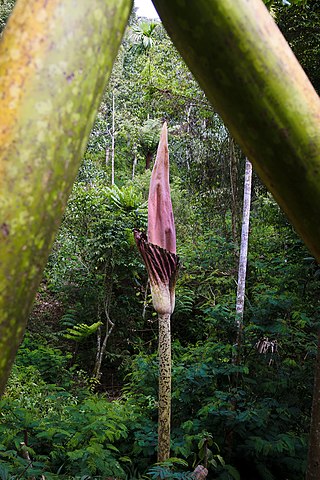
Amorphophallus gigas is a plant in the Arum, or Calla Lily, Family, (Araceae) native to Sumatra. It is also known as Amorphophallus brooksii. It resembles its near relative Amorphophallus titanum in having a very large spadix surrounded by a very large spathe. In both species the inflorescence can be up to 11 ft 4 in in height, has the smell of rotting flesh, and is fly pollinated. According to Bown, the record specimen was 4.36 meters in height, of which 1.5 meters was the spadix. The tuber, a corm, is second in size only to A. titanum at up to 70 kilograms in weight.
Alocasia atropurpurea is a flowering plant in the family Araceae endemic to northern Luzon in the Philippines. It is classified as Critically Endangered by the IUCN Red List of Threatened Species and has only been recorded in Mount Polis and an unspecified locality in the Mountain Province.
Amorphophallus hewittii is geophytic aroid of family Araceae.















